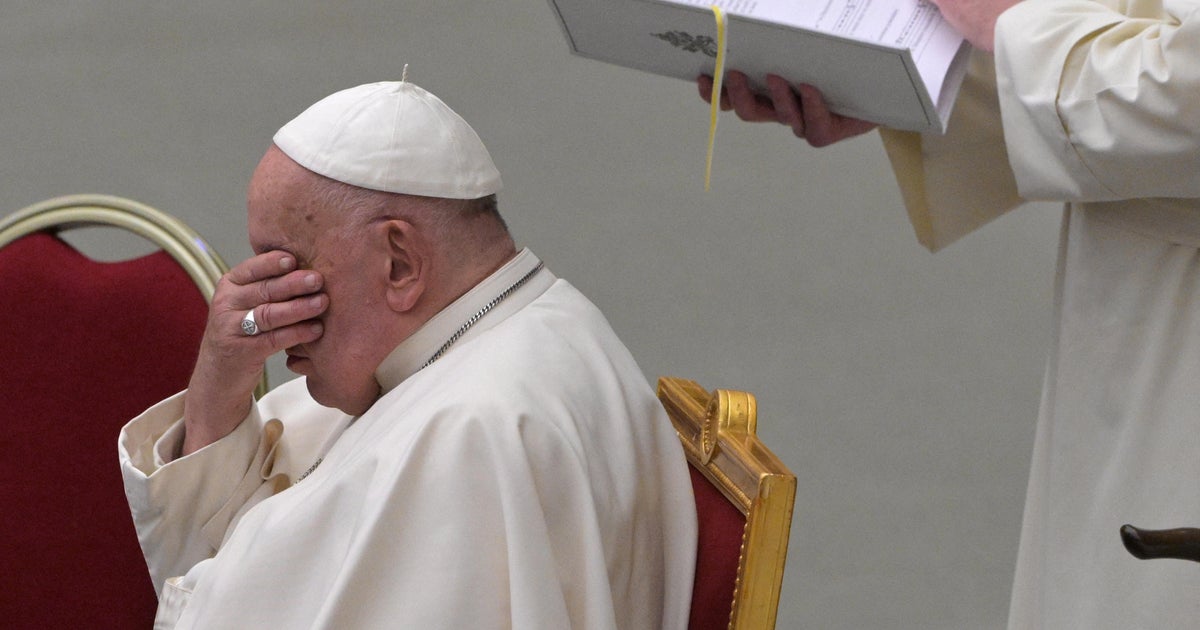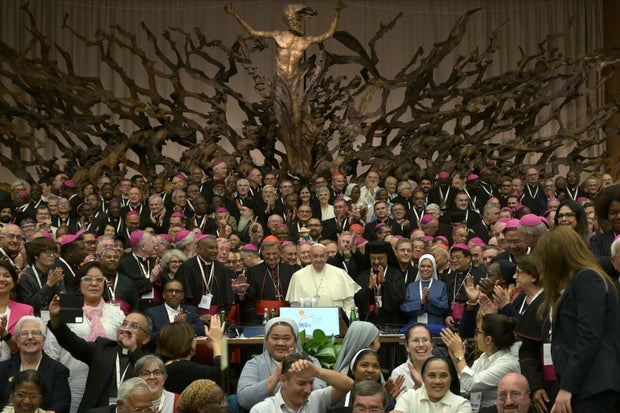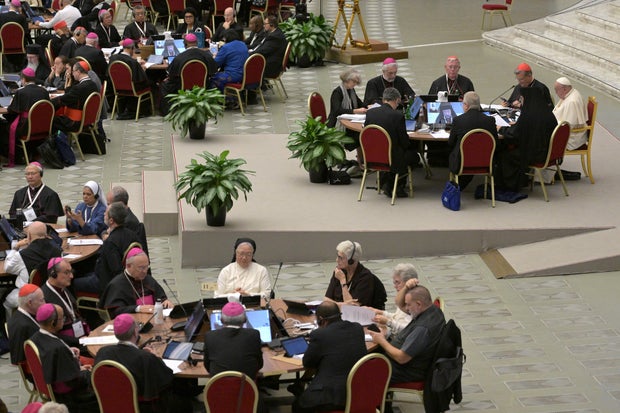CBS News
Purdue Pharma bankruptcy plan that shields Sackler family faces Supreme Court review

Washington — Long before Purdue Pharma filed for bankruptcy, before the series’ “Dopesick” and “Painkiller” brought the Sackler family and devastation of the opioid crisis into Americans’ living rooms, and before her son died of a drug overdose at the age of 33, Ellen Isaacs was sounding the alarm about the opioid epidemic.
Isaacs herself was prescribed OxyContin, the powerful pain killer manufactured by Purdue and promoted as “non-addictive,” after undergoing surgery in the late 90s. That was around the same time her son, Ryan Wroblewski, got a prescription for the drug after injuring his back in a fall from a bridge.
Isaacs weaned herself off the drug in 2001 and became passionate about raising awareness about the dangers of opioids, all while trying to secure help for her son amid his own addiction.
Wroblewski, though, lost his battle five years ago. Isaacs said she began “vehemently” giving out Narcan, a nasal spray used to treat people experiencing an opioid overdose, and appearing on the news to demonstrate how it works.
During the course of her advocacy, Isaacs has protested outside the Justice Department. She wrote a letter to the late Queen Elizabeth II urging her to strip Theresa Sackler, who was married to Purdue co-owner Mortimer Sackler, of her “dame” title. She rallied in White Plains, New York, where a federal bankruptcy judge oversaw Purdue’s bankruptcy and approved legal protections for the Sackler family.
On Monday, Isaacs is set to return to Washington as part of her efforts to fight the bankruptcy plan and, specifically, the decision to release the Sacklers from civil liability for the opioid epidemic. The matter is under review by the Supreme Court, with oral arguments in the case, known as Harrington v. Purdue Pharma L.P., set for Monday morning.
“It’s really important to me that these people get held accountable for all the people that they’ve murdered,” Isaacs told CBS News. “They’re criminals and they needed to be treated as such.”
Douglas Healey / AP
The Purdue Pharma bankruptcy
Purdue filed for Chapter 11 bankruptcy protection in September 2019. Scores of states, local governments, Native American tribes and victims had filed lawsuits against the company seeking damages arising from its manufacture and sale of OxyContin, which helped fuel the opioid epidemic. Purdue separately pleaded guilty in 2007 to a felony count of misbranding OxyContin and has paid more than $600 million in fines and other costs.
Though the Sackler family, which owned Purdue, did not enter bankruptcy, they negotiated a settlement with claimants. The Sacklers agreed to contribute more than $4 billion across a decade — an amount that ultimately rose to $6 billion — toward efforts to fight the opioid crisis. The settlement also includes $750 million to compensate victims, who may be eligible to receive between $3,500 and $48,000.
The agreement requires millions of documents to be made public and for Purdue to restructure itself as a public benefit company, with its profits used to make products that combat opioid addiction.
In exchange, and crucially, the plan included a release that shields the Sacklers from civil lawsuits stemming from the opioid crisis. The family would also potentially be able to keep billions of dollars in revenue from Purdue that was distributed between 2008 and 2017, according to court filings.
The bankruptcy plan was approved by 95% of victims. However, several states, Canadian municipalities and indigenous tribes, plus more than 2,600 individuals, voted against it because of the legal protections for the Sackler family, their affiliates and related entities.
A bankruptcy court in New York, though, approved the plan in September 2021. The states and other detractors challenged the approval in a federal district court in New York. They were joined by the U.S. Trustee, an arm of the Justice Department that oversees the administration of bankruptcy cases.
The group focused on the legality of the plan’s shield for the Sacklers, since even those who refused to approve the deal cannot pursue claims against them. A federal district court agreed, and in December 2021 it rejected the plan.
Purdue and other plan proponents appealed to the U.S. Court of Appeals for the 2nd Circuit. While their case was pending, the District of Columbia and the eight states that had objected to the deal reached an agreement with Purdue and the Sacklers for them to boost their proposed contribution to the bankruptcy estate by $1.75 billion — bringing their total contributions to between $5.5 billion and $6 billion.
A divided 2nd Circuit panel reversed the district court’s decision in May, after which the Justice Department asked the Supreme Court to review the appeals court’s ruling and temporarily put the bankruptcy plan on hold. The high court agreed to pause the plan in August and said it would take the case.
Carolyn Kaster / AP
A division among victims
The issue before the court is whether detractors from federal bankruptcy agreements can be bound by releases that shield entities that have not declared bankruptcy themselves, like the Sacklers.
“The question will be, does the code need to specifically allow or specifically prohibit these types of releases?” Anthony Casey, a law professor at the University of Chicago, told CBS News. “That’s the question the court is asking.”
The U.S. Trustee, represented by the Justice Department, has argued that the agreement to exempt the Sacklers, who did not file for bankruptcy, from civil lawsuits violates federal law. The government is urging the Supreme Court to reject the plan.
The case has split victims of the opioid crisis and families who lost loved ones to overdoses. A group of more than 60,000 people affected by Purdue’s opioid products said the plan settlement “represents a watershed moment” and offers the “best (and perhaps only path forward)” for those seeking to hold Purdue accountable.
“Save for one personal injury appellant, the actual victims here want this plan, want the releases, and want closure, not the opportunity for endless, damaging, and assumedly futile litigation against the Sacklers,” they told the justices in a filing.
Similarly, 15 others who are victims themselves or whose loved ones were, told the justices in a filing that the bankruptcy plan approved by the 2nd Circuit “supplies the only viable mechanism for affording victims the aid they need — and need now,” and will help provide increased resources for treatment and prevention to stem the opioid epidemic.
“No amount of money can bring back a beloved family member lost to addiction or undo the traumas routinely caused by opioid addiction,” they said. “The confirmed reorganization plan, however, is needed — and needed now — to provide monetary relief to long-suffering victims of the opioid epidemic — and also to prevent more families and communities from suffering the same fate.”
But Isaacs, as an opponent of the plan, said she should be able to pursue her own case against the Sacklers in front of a jury of peers.
“Here, we have several family members on the board [of Purdue] and they turn around and they make this product, it turns out to be a drug that is killing now over 1 million people, and there’s no accountability,” she said.
Isaacs recalled receiving her ballot to vote on the plan, which recommended a “yes” vote. She said it was “ludicrous that someone wants to speak for me.”
“It’s just all wrong,” she said. “I want my day with Richard Sackler.”
Michael Quinn, Isaacs’ attorney, said the release for the Sacklers amounts to special protection that is not afforded to others.
“The Sacklers have at their availability, because of these releases, an escape hatch from liability, whereas people like you, me and Ellen would never have that ability to escape liability,” he said. “We don’t have billions of dollars to push a carcass of a company into bankruptcy and then hide behind it.”
The third-party releases at issue in the case allow corporate owners and decision-makers to “shirk their responsibility for risky decisions,” he said.
“If these nondebtor releases are upheld by the Supreme Court, then suddenly every company can act with impunity and the individuals will always be able to get away with it,” Quinn said.
Toby Talbot / AP
The impacts of a decision
Casey said third-party releases are common in major Chapter 11 bankruptcies and warned that if the court ultimately rejects Purdue’s bankruptcy plan and says these protections are not allowed, it would have reverberations across the bankruptcy system. A decision is expected by the summer.
“There’s lots of pending mass tort cases which they were planning on and hoping for third-party releases that would have to revisit this,” Casey said.
One such pending case involves the Boy Scouts of America, which entered Chapter 11 bankruptcy proceedings in 2020 after it was named in numerous lawsuits alleging sexual abuse. The organization emerged from bankruptcy in April with a reorganization plan that was approved by 85% of voting survivors, and then confirmed by a bankruptcy court followed by a federal district court.
The Boy Scouts’ agreement includes a trust with nearly $2.5 billion in cash, as well as releases for nonprofit local councils, chartering organizations and other third parties. The group warned in a filing that if the Supreme Court finds these third-party releases are not allowed by the bankruptcy code, it would have “devastating consequences for both victims and venerable non-profit institutions in mass-tort situations.”
The U.S. Conference of Catholic Bishops also urged the court to uphold the 2nd Circuit’s decision, citing the releases from liability that were included in reorganization plans for dozens of dioceses who filed for bankruptcy after facing litigation related to sexual abuse allegations.
“Although the Church deeply regrets abuse and acknowledges the need to compensate victims, the Bankruptcy Code has long been understood to give them a fair, orderly, and lawful pathway out of the thicket of mass tort liability that now envelops them so that they can carry on the Church’s mission,” the group, whose members are active Catholic bishops, told the justices. “The court should not close off that pathway in this case.”
CBS News
Navy issues apology for destroying Alaska Native village in 1882

Shells fell on the Alaska Native village as winter approached, and then sailors landed and burned what was left of homes, food caches and canoes. Conditions grew so dire in the following months that elders sacrificed their own lives to spare food for surviving children.
It was Oct. 26, 1882, in Angoon, a Tlingit village of about 420 people in the southeastern Alaska panhandle. Now, 142 years later, the perpetrator of the bombardment — the U.S. Navy —has apologized.
Rear Adm. Mark Sucato, the commander of the Navy’s northwest region, issued the apology during an at-times emotional ceremony Saturday, the anniversary of the atrocity.
“The Navy recognizes the pain and suffering inflicted upon the Tlingit people, and we acknowledge these wrongful actions resulted in the loss of life, the loss of resources, the loss of culture, and created and inflicted intergenerational trauma on these clans,” he said during the ceremony, which was livestreamed from Angoon. “The Navy takes the significance of this action very, very seriously and knows an apology is long overdue.”
While the rebuilt Angoon received $90,000 in a settlement with the Department of Interior in 1973, village leaders have for decades sought an apology as well, beginning each yearly remembrance by asking three times, “Is there anyone here from the Navy to apologize?”
“You can imagine the generations of people that have died since 1882 that have wondered what had happened, why it happened, and wanted an apology of some sort, because in our minds, we didn’t do anything wrong,” said Daniel Johnson Jr., a tribal head in Angoon.
The attack was one of a series of conflicts between the American military and Alaska Natives in the years after the U.S. bought the territory from Russia in 1867. The U.S. Navy issued an apology last month for destroying the nearby village of Kake in 1869, and the Army has indicated that it plans to apologize for shelling Wrangell, also in southeast Alaska, that year, though no date has been set.
Chief Mass Communication Spc. Gretchen Albrecht/U.S. Navy via AP
The Navy acknowledges the actions it undertook or ordered in Angoon and Kake caused deaths, a loss of resources and multigenerational trauma, Navy civilian spokesperson Julianne Leinenveber said in an email prior to the event.
“An apology is not only warranted, but long overdue,” she said.
Today, Angoon remains a quaint village of about 420 people, with colorful old homes and totem poles clustered on the west side of Admiralty Island, accessible by ferry or float plane, in the Tongass National Forest, the nation’s largest. The residents are vastly outnumbered by brown bears, and the village in recent years has strived to foster its ecotourism industry. Bald eagles and humpback whales abound, and the salmon and halibut fishing is excellent.
Accounts vary as to what prompted its destruction, but they generally begin with the accidental death of a Tlingit shaman, Tith Klane. Klane was killed when a harpoon gun exploded on a whaling ship owned by his employer, the North West Trading Co.
The Navy’s version says tribal members forced the vessel to shore, possibly took hostages and, in accordance with their customs, demanded 200 blankets in compensation.
The company declined to provide the blankets and ordered the Tlingits to return to work. Instead, in sorrow, they painted their faces with coal tar and tallow — something the company’s employees took as a precursor to an insurrection. The company’s superintendent then sought help from Naval Cmdr. E.C. Merriman, the top U.S. official in Alaska, saying a Tlingit uprising threatened the lives and property of White residents.
The Tlingit version contends the boat’s crew, which included Tlingit members, likely remained with the vessel out of respect, planning to attend the funeral, and that no hostages were taken. Johnson said the tribe never would have demanded compensation so soon after the death.
Merriman arrived on Oct. 25 and insisted the tribe provide 400 blankets by noon the next day as punishment for disobedience. When the Tlingits turned over just 81, Merriman attacked, destroying 12 clan houses, smaller homes, canoes and the village’s food stores.
Six children died in the attack, and “there’s untold numbers of elderly and infants who died that winter of both cold, exposure and hunger,” Johnson said.
Billy Jones, Tith Klane’s nephew, was 13 when Angoon was destroyed. Around 1950, he recorded two interviews, and his account was later included in a booklet prepared for the 100th anniversary of the bombing in 1982.
“They left us homeless on the beach,” Jones said.
Rosita Worl, the president of Sealaska Heritage Institute in Juneau, described how some elders that winter “walked into the forest” — meaning they died, sacrificing themselves so the younger people would have more food.
Even though the Navy’s written history conflicts with the Tlingit oral tradition, the Navy defers to the tribe’s account “out of respect for the long-lasting impacts these tragic incidents had on the affected clans,” said Leinenveber, the Navy spokesperson.
Tlingit leaders were so stunned when Navy officials told them, during a Zoom call in May, that the apology would finally be forthcoming that no one spoke for five minutes, Johnson said.
Eunice James, of Juneau, a descendant of Tith Klane, said she hopes the apology helps her family and the entire community heal. She expects his presence at the ceremony.
“Not only his spirit will be there, but the spirit of many of our ancestors, because we’ve lost so many,” she said.
CBS News
Pope Francis’ Catholic church reform process ends without giving more equity to women

Pope Francis’ yearslong process to reform the Catholic Church closed Saturday with recommendations that fell short of giving women more equity as hoped but reflected the pope’s aims for a church that at least listens more to its followers.
In a significant move, the pope said he would not issue a teaching document from the recommendations, which called for women to be allowed all opportunities that Church law already provides while leaving open the contentious question of allowing women to be ordained as deacons.
As a result, it remains unclear what if any authority or impact the synod’s final recommendations will have, given the purpose of the exercise was to provide the pope with specific proposals on reform.
“In this time of war, we must be witnesses to peace” and give an example of living with differences, the pope said in explaining his decision.
TIZIANA FABI/AFP via Getty Images
Francis said he would continue to listen to the bishops’ counsel, adding “this is not a classic way of endlessly delaying decisions.”
Deacons perform many of the same functions as priests, such as presiding over baptisms, weddings and funerals, but they cannot celebrate Mass. Advocates say allowing women to be deacons would help offset the shortage of priests. Opponents say it would signal the start of a slippery slope toward ordaining women to the all-male priesthood that Francis has repeatedly reaffirmed.
Earlier this week, the Vatican’s top doctrinal officer, Cardinal Victor Manuel Fernandez, told the extraordinary assembly of 368 bishops and laypeople that Francis had said the moment “is not ripe” for allowing the ordination of women as deacons. He did not respond directly to a request to define what would determine “ripeness” for a greater role for women.
The multi-year synod process had sparked great hopes for change, especially for women, who have long complained that they are treated as second-class citizens in the church. Women are barred from the church’s highest ministerial positions, yet do the lion’s share of the work running Catholic hospitals and schools and passing the faith onto future generations.
Speaking to the synod on Thursday, Fernandez explained that a special working group would continue beyond the closing of the meeting, but that its focus would be on discussing the role of women in the church — not in the diaconate, or the office of deacon. He added that while working with women in previous pastoral roles, “most did not ask for or want the diaconate, which would be cumbersome for their lay work.”
The meeting asked for “full implementation of all the opportunities already provided for in Canon Law with regard to the role of women, particularly in those places where they remain under-explored.” It leaves open “the question of women’s access to diaconal ministry.”
TIZIANA FABI/AFP via Getty Images
It was the most contested paragraph of the final document, with 258 votes for and 97 against. It was not clear if the “no” votes were because the language went too far or not far enough.
The outcome is a disappointment for Catholics who have been campaigning for recognition that women share a spiritual calling that is no different than a man’s. They also noted that despite the inclusion of women in the synodal process, the working group that is guiding discussions on women’s role is being run by the Roman curia, operating outside the synod.
“I think the final document will be received with much disappointment and frustration by many women around the world who are hoping for concrete changes,” said Kate McElwee, the executive director of the Women’s Ordination Conference.
While she acknowledged a “cultural shift,” she said “the pace of that shift is perhaps too slow for many women.”
The first phase of the synod process ended last year by concluding it was “urgent” to guarantee fuller participation by women in church governance positions, and calling for theological and pastoral research to continue about allowing women to be deacons.
If before the synod the idea of allowing women to be deacons was a fringe proposal pushed by Western progressives, the idea gained attention during the debate. It became something of a litmus test of how far the church was going to go, or not, to address demands of women for greater equality and representation in the church’s highest ranks.
Francis, had other ideas, insisting that ordaining women would just “clericalize” them and that there were plenty of other ways to empower women in the church, even leading Catholic communities, without resorting to ordination.
CBS News
Jim Donovan, Cleveland Browns play-by-play announcer and TV sports anchor, dies of cancer at 68

Jim Donovan, the beloved radio play-by-play announcer for the Cleveland Browns and a TV sports fixture for more than four decades, died Saturday. He was 68.
Donovan retired from his broadcast career earlier this year and stepped away from his game-day duties with the team before this season while battling cancer. Donovan announced his retirement from WKYC on May 30 and worked his final broadcast as a sports anchor on June 10. He had called Cleveland’s games since the team’s expansion rebirth in 1999.
David Richard / AP
“This is an incredibly difficult day for us and the entire Cleveland Browns organization,” Browns owners Dee and Jimmy Haslam said in a statement. “His impact as the Voice of the Browns for 25 years is immeasurable as he touched the lives of our fans each and every Sunday with his love for the Browns and his brilliance at his craft.
“He will be greatly missed, but he cemented a legacy that will live on forever. The only thing that outweighed his love for this city and this team was the love he had for his family. Our thoughts and prayers are with his wife, Cheryl, his daughter, Meghan, and everyone who was fortunate enough to call Jimmy family or friend.”
A Boston native known to everyone as “Jimmy,” Donovan endeared himself to Cleveland fans with his passion, sense of humor and professionalism. He was a stickler for detail, spending countless hours preparing for game broadcasts.
Donovan had recently been inducted into the Browns’ Legends Club and the Greater Cleveland Sports Hall of Fame. He had been too ill to attend the events.
When he was forced to step down in August, Donovan wrote a letter to Browns fans expressing his gratitude for their support.
“I have called Browns games for 25 years. Not a day has gone by when I haven’t paused and been so proud to be ‘The Voice of the Browns,'” he wrote. “Cheryl, Meghan and I thank you for all the love, support and prayers during my rough patches. It’s like having a huge family around us. And that’s what makes the Cleveland Browns so special. You do.”
Donovan had to step away as sports director at WKYC-TV last fall for several months to undergo treatment for leukemia. He returned to the broadcast booth in time to call the team’s late-season run to the playoffs.
Donovan was first diagnosed with chronic lymphocytic leukemia, a strain of the disease that starts in white blood cells and affects bone marrow, in 2000. He underwent a bone marrow surgery in 2011.
A graduate of Boston University, Donovan got to Cleveland in 1985. Along with doing local reporting of the city’s three professional sports franchises, Donovan also had several national network assignments and was part of NBC’s coverage team at the 1992 and 1996 Summer Olympics.










